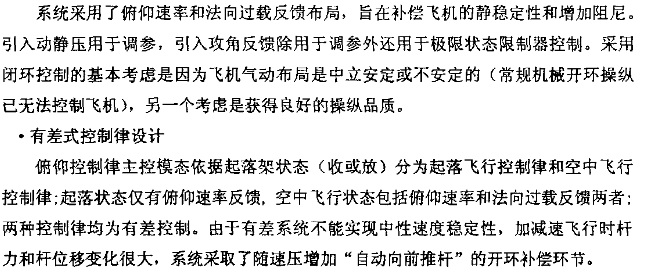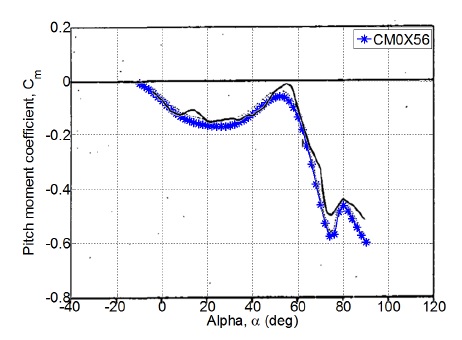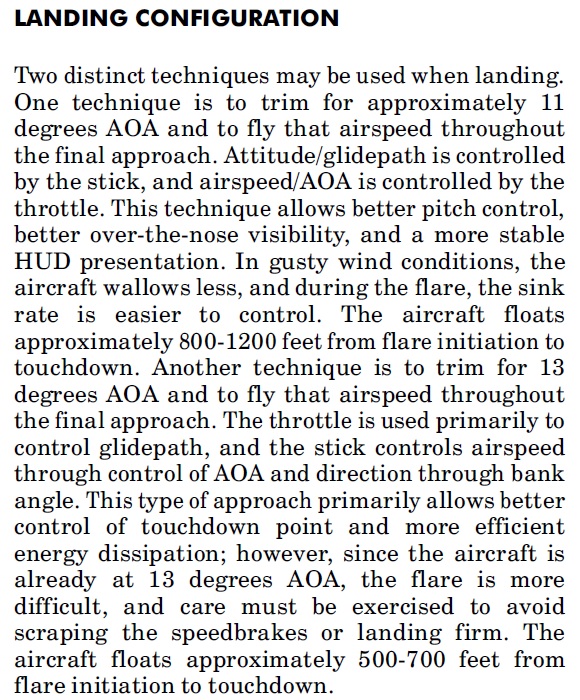-
Posts
509 -
Joined
-
Last visited
-
Days Won
1
Content Type
Profiles
Forums
Events
Everything posted by LJQCN101
-

Using "throttle for GS and stick for AOA" when landing
LJQCN101 replied to LJQCN101's topic in DCS: F/A-18C
I just managed to use throttle only for glide slope and stick only for banking the aircraft. And a 3-wire! Track is attached:Su33 carrier landing with no pitch input.trk -

Using "throttle for GS and stick for AOA" when landing
LJQCN101 replied to LJQCN101's topic in DCS: F/A-18C
We just have the same word, it is also speed stability, in stability & control region. -

Using "throttle for GS and stick for AOA" when landing
LJQCN101 replied to LJQCN101's topic in DCS: F/A-18C
Looks like it does have different ways to measure speed stability. In longitudinal stability & control, speed stability is measured with aircraft (including throttle) trimmed to maintain a certain airspeed. With airspeed increase/decrease after a disturbance, a speed stable aircraft tends to pitch up/down and return to it's original trimmed airspeed. Notice there's no throttle change here. Also here's another explanation: http://www.boeing.com/commercial/aeromagazine/aero_02/textonly/fo01txt.html In flight control systems, we have neutral speed stability control law which is characterised by 1G hands-off auto trim, with the aircraft not pitching up and down when changing airspeed. You can find some mentions about speed stability in DCS Su-27 manual, longitudinal control systems part, where it have a airspeed trimming law to mimic a speed stable aircraft. -

Using "throttle for GS and stick for AOA" when landing
LJQCN101 replied to LJQCN101's topic in DCS: F/A-18C
No quite the case in F18 if FLAPS is at AUTO, when the system trims for 1G hands-off flight and you actually have to push the stick forward to fly out of the backside of the curve and gain speed. That's neutral speed stability. In contrary, with FLAPS at half/full, the system trims for 8.1 deg AOA hands-off so the speed stability of the aircraft changed to positive. Then speed change would result in pitch up/down, nothing to do with the power curve. -

Using "throttle for GS and stick for AOA" when landing
LJQCN101 replied to LJQCN101's topic in DCS: F/A-18C
If talking about F-18 with FLAPS half/full, even flying at the backside of the power curve, releasing the stick would immediately cause nose drop and a strong tendency to return to 8.1 deg AOA (with neutral pitch trim). If you want to keep flying on the backside of the curve, an increasing amount of back pressure on stick is needed. Basically it's still like speed stable, but it wants to return to a constant AOA. -

Using "throttle for GS and stick for AOA" when landing
LJQCN101 replied to LJQCN101's topic in DCS: F/A-18C
You mean the speed stability will go negative when the aircraft would pitch up with a decreasing speed and a neutral stick? May happen above stall AOA though. -

Using "throttle for GS and stick for AOA" when landing
LJQCN101 replied to LJQCN101's topic in DCS: F/A-18C
Yeah, you can do this with any speed stable aircraft, either aerodynamically or mimicked by FCS. In a F18, you'll experience an even stronger speed stability since it directly uses AOA feedback to automatically trim for on-speed AOA. Well, I tried many times with Su33, that you can manually trim for a point where AOA donut is green with zero pitch rate. From then on, an increase in speed of only 10 km/h will result in pitch up by the aircraft itself, without touching the stick. A decrease in speed will make the aircraft pitch down as well. It's just a matter of how speed stable the aircraft is. -

Using "throttle for GS and stick for AOA" when landing
LJQCN101 replied to LJQCN101's topic in DCS: F/A-18C
Just some findings from FCS perspective which I think it's worth to expand when Wags mentioned about PA mode in the mini-updates, in case people find out that FCS is fighting their input;) -
While preparing for the upcoming module, I found this in the NATOPS manual describing landing and takeoff characteristics of F18 FCS: So the FCS actually encourages what we known as "throttle for GS and stick for AOA". An increase in throttle would result in a decrease in AOA, which would make the aircraft pull up by itself, so that AOA is maintained. This would make carrier landing a lot easier than Su-33 IMO.
-
Oh thanks. I didn't check that for a long time.
-
I think there's still a 3-minute gyro spin up time for EO mavs?
-
Just an interesting find. Looks like for IR version it would not be easy to operate. There's a 3-minute cool down time. But there's also an 1-hour time limit for RDY & video off, and 30-minute limit for RDY & video on. (Which is probably implemented.) And after the missiles are RDY, you have to do boresight alignment procedure one by one for all of them. Would cause hand-off failure if you didn't do it. (Not implemented.) When shooting the mavericks, there's a keyhole constraint. When shot outside the keyhole, there's a chance to miss the target. (Edit: Implemented in DCS A10C.)
-
Deka themself uses the term "JF-17".
-
F18 also go STT with single designate from RWS (without LTWS selected):
-
The AOA feeback is in the control law, which produces an aircraft nose-down command proportional to AOA above 22 degrees. So pilot would pull more above 22deg AOA. This is not force feedback applied on the stick, but FCS feedback that will affect control surface deflection. BTW I really want to see a 35 pound force FFB stick. Now I'm just sticking to my 22-pound X65F.
-
First I'll state the sources. 1. 中国航空工业总公司第601所 (AVIC No.601, Shenyang Aircraft Design Institute): http://www.doc88.com/p-9139796730763.html Translation: SDU in Takeoff-Landing Mode only has pitch-rate feedback, while Flight Mode includes both pitch-rate and Nz feedback. Both are systems with steady-state error. Those systems cannot achieve neutral speed stability, and can cause a great variation of stick force and stick position when changing speeds, so an open-loop compensation was added to "automatically push the stick forward" as dynamic pressure increases. 2. 中国飞行试验研究院 (China Flight Test Research Institute, by test pilot Xu): https://www.doc88.com/p-3857487861687.html Translation: When flying below 0.85 Mach, the aircraft has an auto-trim function, and the pilot seldom has the need to re-trim the aircraft. The paper from Shenyang 601 institute states that such a system has steady-state error, which is expected since the system doesn't use an integrator to eliminate errors between command and feedback. Therefore an open-loop compensation law is added to reduce the amount of forward trimming as airspeed increases, as contrary to DCS implementations. (But it does not completely achieves neutral speed stability, since the system does not have an integrator.)
-

FCS pitch response comparison between Su27 and Su33
LJQCN101 replied to LJQCN101's topic in Su-33 for DCS World
Flight control plays its role too. It seems that Su-33 uses a much more optimized pitch rate/loop gain schedule than Su-27 which enables it to deflect its elevator faster for the same pitch command. Therefore, Su-33 applied a greater force at one end of the stick. -
Su33 in game moves its stabilizer much quicker than Su27: https://forums.eagle.ru/showthread.php?t=194015 Both Su27 and Su33 in game behaves like a static stable aircraft below 22-24deg AOA (with S Pressed). Static stability became neutral when approaching 24deg AOA, and became negative when above. The Cm curve just feels like this:
-
Both are allowed in a F-16: There's a reason why Navy don't use the first technique. You'll have a burble zone just close to touch down. One day you come in and you have nothing but smooth air and a small drop (add a little power) 1 second before touchdown for the easy 3 wire. The very next time a few hours later you come in and you are dropping like a rock just 200 ft away on approach going full throttle hearing LSO (screaming "POWER") catching the 1 wire and getting a no grade or missing the wires and boltering. If you increase pitch for that, it lowers the hook (risking an in-flight engagement, hook slap or ramp strike). If you reduce pitch, it raises the hook, increasing the chance of missing all 4 wires (a bolter).
-
Yes, both stick and throttle should be used for any corrections, but there're some fundamental differences in pilot reaction to AOA/GS changes. 1. If you choose to use throttle for AOA and stick for GS, the throttle is used only as a function of AOA. Imagine when you activated auto throttle control which trims for on-speed AOA. When AOA is larger than optimum value, throttle will be increased regardless of GS. Then you use the stick to aim for GS. 2. If you choose to use throttle for GS and stick for AOA, the stick is used only as a function of AOA. We have one real life example. In takeoff and landing mode of F18, the FCS will automatically trim for 8.1deg AOA hands-off whenever AOA is above 6deg. When the throttle is advanced, AOA is decreased. Then the system will command nose up to aim for trim AOA. Vice versa, throttle decrease will result in nose down. That's how you use throttle to adjust GS in a F18 with little to none stick input.
-
F18 Navy Pilot quote about stick and throttle control:
-
This is a recently corrected feature. Same IRL.
-
Just an interesting find. I did a simple test to compare the short period pitch characteristics and FCS response of both aircraft. In Su27, pitch response is much slower when reacting to a full aft-stick command. It also takes longer for Su27 to reach a certain pitch rate compared to Su33. When controls are released, Su33 recovers faster to zero pitch rate. Su27: Su33: You can notice the FCS of Su33 drives the horizontal stabilizer much quicker and to a larger extent when responding to the same pitch command.








